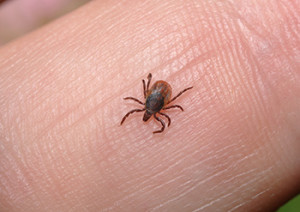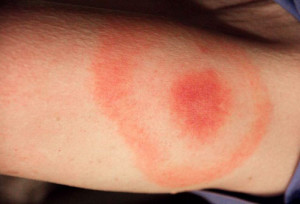Ticks – A “Buggy” Danger

Summer! Long hot days… lemonade… sun… and BUGS! Yes, summer is notoriously known for bees, ants, and mosquitoes, but now we can add another bug to that list… TICKS! Ticks are tiny insects that thrive in moist, warm climates. Ohio has seen an increase in ticks since 2010 as more of them hitch rides on the backs of deer that are migrating from Pennsylvania. The deer ticks are now present in nearly 75 percent of Ohio counties.
Ticks live by attaching themselves to the skin of a human or animal and ingesting the blood. Ticks can stay imbedded on a body for up to three days while it ingests the blood needed for its reproduction. Once satisfied, the tick backs out of the skin and falls off to lay its eggs and then repeats the same process for up to three years.
Ticks are not only a nuisance like many other bugs, but can be a serious danger to humans and pets! Most species of ticks are harmless, but the deer tick can carry Lyme disease and other infectious diseases. The deer tick infects humans and animals once imbedded in the skin by releasing a toxin into the victim.
Lyme disease is a serious illness that if not treated promptly can lead to long term complications including joint arthritis, nervous system problems, and inflammation of th e heart. Symptoms include fever, fatigue, headache and a unique rash called a “bull’s-eye” rash. Between 2012 and 2014 Lyme disease infections reported in Ohio jumped from 66 to 119 cases.
e heart. Symptoms include fever, fatigue, headache and a unique rash called a “bull’s-eye” rash. Between 2012 and 2014 Lyme disease infections reported in Ohio jumped from 66 to 119 cases.
Diagnosis of a tick-borne illness such as Lyme disease is usually based upon a history of exposure. Sometimes, a rash or lesion may provide the first clue. Blood tests can help confirm diagnoses, but their results can be unreliable if the test is administered too soon. Treatment for a tick-borne illness may include antibiotics and other therapies.
Prevention
The best treatment for tick-borne diseases is PREVENTION! Preventative techniques include:
- Wearing repellents that contain 20 to 30 percent DEET on exposed skin and clothing.
- Treating clothing and gear with products containing 0.5 percent permethrin.
- Showering soon after being outdoors- within 2 hours.
- Checking for ticks daily, especially under the arms, in and around the ears, behind the knees and around the hairline and scalp.
- Treating dogs and cats for ticks as recommended by a veterinarian.
Removal
If you find a tick imbedded in your skin, the CDC cites the following steps for tick removal:
- Use fine-tipped tweezers to grasp the tick as close to the skin’s surface as possible.
- Use a steady even pressure to pull the tick out of the skin.
- Do not twist or jerk the tick, as this can cause the mouth parts to break off and remain in the skin.
- After removing the tick, the bite area should be cleaned with rubbing alcohol or soap and water.
Tags: bugs, lyme disease, prevention, removal, summer, ticks
